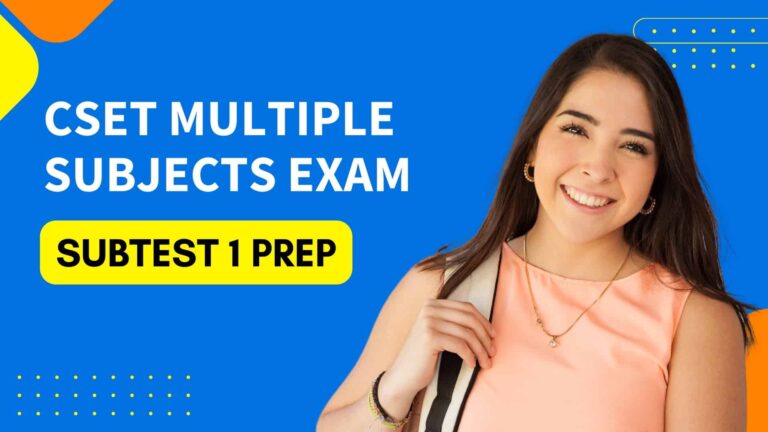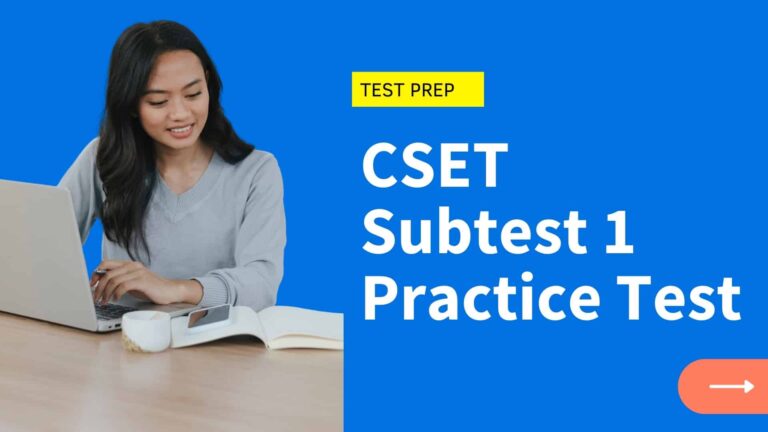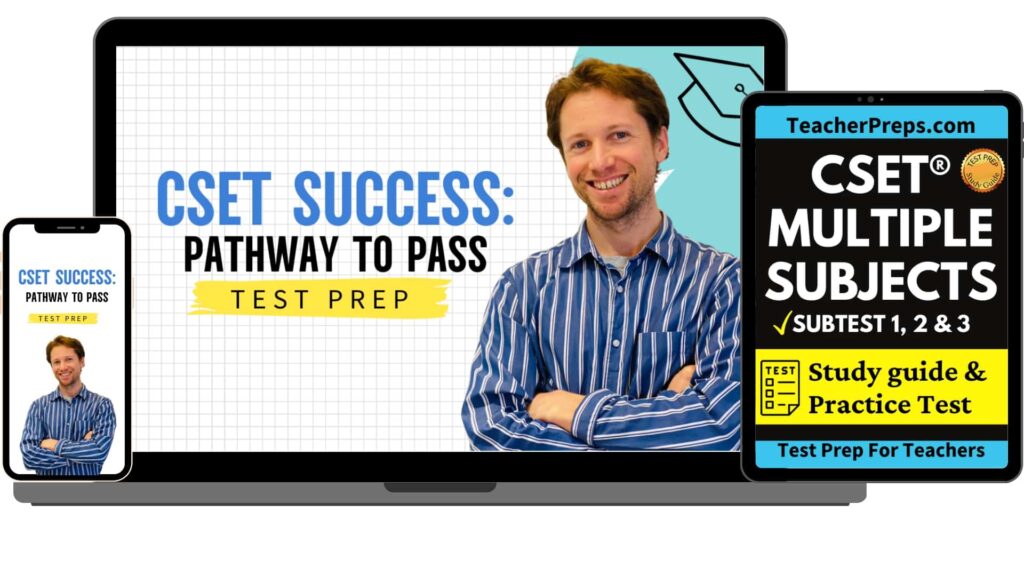
Ace Your CSET Multiple Subjects, Subtest 1 Exam
Feeling nervous about your CSET Multiple Subjects, Subtest 1 exam? Not to worry, you’ve come to the right place. Our comprehensive test prep platform offers all the materials you need to pass, bundled together for your convenience. From study guides and vocabulary games to an AI-driven essay grader and full-length practice tests, we’ve got you covered. Dive into our resources and start your journey to passing Subtest 1 with confidence.
Overview
Our full-length CSET Multiple Subjects Subtest 1 practice test is designed to mirror the actual exam experience. It includes:
- 52 Multiple-Choice Questions: Covering key topics in Reading, Language, and Literature; and History and Social Science.
- Four Constructed-Response Assignments: Test your ability to apply your knowledge in written form.
- Domain Results Worksheet: Track your performance in each domain to focus your study efforts effectively.
Test Format
Our practice test is divided into two main sections:
-
Multiple-Choice Question Section:
- Each question offers four possible answers—only one is correct.
- Carefully read each question and select the ONE best answer.
- Answers should be recorded on the provided answer sheet.
-
Constructed-Response Assignment Section:
- This section requires detailed written responses.
- Directions specific to each assignment will guide you on how to respond.
- You can tackle the multiple-choice and constructed-response sections in any order.
Testing Strategy
- Timing: If you are taking only Subtest I, you will have a three-hour session to complete this subtest. For those taking all three subtests, a five-hour session is allotted.
- Strategy Tips:
- Pace Yourself: Monitor how long you spend on each section during practice to better manage your time on test day.
- Answer Strategically: If unsure, eliminate obviously incorrect answers first to improve your chances of selecting the right one.
- Review and Reflect: Use the Domain Results Worksheet to identify areas where you need further study.
With these resources and strategies, our test prep materials provide a comprehensive approach to help you feel prepared and confident. Get full access to everything you need to succeed on the CSET Multiple Subjects, Subtest 1. Start your prep today and turn your test anxiety into achievement!
CSET Multiple Subject Subtest 1 Study Guide
Subtest 1 Exam: Language and Linguistics
Introduction to Fundamental Components of Human Language
As you gear up for the CSET Multiple Subjects exam, understanding the fundamental components of human language is critical. These building blocks of language are essential not just for classroom success, but also for acing the exam.
Understanding the Importance of Language Structure in Communication
Language is more than just a tool for communication; it reflects cognitive abilities and cultural identities. Knowing the structure of language is crucial for educators, as it shapes how students perceive and interact with their world.
Overview of the Fundamental Components:
Phonology:
- Definition: Study of sounds and their patterns in a language.
- Example: Differentiating “bit” from “beat” illustrates the importance of understanding vowel sounds and their lengths.
Morphology:
- Definition: Examines how words are formed from morphemes.
- Example: “Unbelievable” combines “un-“, “believe”, and “-able” to form a new word.
Syntax:
- Definition: Concerns the arrangement of words into sentences.
- Example: “The cat sat on the mat” is a syntactically correct sentence.
Semantics:
- Definition: Focuses on the meaning of words and phrases.
- Example: “Bank” can mean either the edge of a river or a financial institution, depending on the context.
Pragmatics and Its Role in Language Usage
Pragmatics is about how context affects the interpretation of language. This includes understanding idioms, jokes, and implied meanings.
- Example: “Can you open the window?” in a stuffy room is likely a request rather than a question about capability.
Linguistic Diversity and Universality
Recognizing the diversity and commonalities in languages aids in understanding and answering exam questions related to language comparison and universal grammar.
Differences Among Languages:
- Example: Adjective placement differs between English (“green apple”) and Spanish (“manzana verde”).
Universality of Linguistic Structures:
- Example: All languages have mechanisms for asking questions, though the structure differs, like the inversion in English vs. a particle in Mandarin.
Phonemic Awareness
Improving your phonemic awareness is vital for the exam as it often assesses your ability to distinguish and manipulate sounds.
- Understanding Phonemic Processes:
- Rhyming: Recognizing words that sound similar at the end, like “cat,” “hat,” and “bat.”
- Segmenting: Breaking down “dog” into its individual sounds: /d/, /o/, /g/.
- Blending: Combining /s/, /l/, /i/, /p/ to form “slip.”
Phoneme Awareness vs. Phonics
Distinguishing between phoneme awareness and phonics is crucial for the exam.
Phoneme Awareness:
- Definition: The ability to hear and manipulate phonemes without visual cues.
- Example: Distinguishing the phonemic difference in “cat” vs. “cut.”
Phonics:
- Definition: Relates phonemes to their corresponding graphemes and is essential for reading.
- Example: Knowing different spellings for the sound /k/ as in “cat,” “kite,” or “back.”
Morphology and Parts of Speech
Understanding morphology and parts of speech is key to grasping the structure and function of language.
Identifying and Understanding Parts of Speech:
- Functions: Explains the role of words in a sentence (e.g., nouns name, verbs action).
- Morphology: How word forms change to express different grammatical categories.
Morphological Classification of Words:
- Definition: Categorizing words based on structure, such as root words and affixes.
- Example: “Unhappiness” includes the root “happy,” prefix “un-“, and suffix “-ness.”
Syntax and Sentence Development
Understanding syntax involves recognizing components used to construct sentences.
- Recognizing Syntactic Components:
- Phrases: Building blocks of sentences that add meaning.
- Example: In “The quick brown fox jumps over the lazy dog,” phrases describe the fox and the dog.
Clauses, Including Verbals:
- Definition: Clauses are groups of words with a subject and verb. Verbals are verbs acting as different parts of speech.
- Example of a Clause: “When the sun sets” is a dependent clause.
- Example of a Verbal: In “Running is fun,” “Running” is a gerund (verb functioning as a noun).
Using Syntactic Components to Construct Different Sentence Types:
Simple Sentences:
- Definition: A sentence containing a single independent clause.
- Example: “The dog barks.”
Compound Sentences:
- Definition: A sentence made up of two or more independent clauses, usually joined by a conjunction or semicolon.
- Example: “The dog barks, and the cat meows.”
Complex Sentences:
- Definition: A sentence that includes one independent clause and at least one dependent clause.
- Example: “Although the dog barks, the cat remains calm.”
VII. Conclusion
As you conclude your preparation for the CSET Multiple Subjects exam, it’s essential to consolidate your understanding of the key linguistic concepts that are crucial for obtaining your Teaching Credentials.
A. Recap of Key Linguistic Concepts for Multiple Subject Teaching Credentials
- Phonology: Understanding the sound system of language.
- Morphology: Recognizing how words are formed and structured.
- Syntax: Grasping sentence structure and the arrangement of words.
- Semantics: Comprehending word meanings and sentence interpretations.
- Pragmatics: Applying language in various contexts.
- Phonemic Awareness: Identifying and manipulating individual sounds in speech.
- Phonics and Alphabetic Principle: Relating sounds to their corresponding letters and patterns.
- Syntax and Sentence Development: Constructing and analyzing different types of sentences.
B. The Importance of Linguistic Knowledge in Teaching and Communication
Linguistic knowledge is foundational for effective teaching, particularly in language arts and reading instruction. Understanding these concepts enables you to better support students in developing their language and literacy skills. In the classroom, this knowledge aids in recognizing and addressing diverse language needs and in fostering a more inclusive learning environment. On the CSET exam, your grasp of these concepts is directly tested, and a strong understanding is crucial for your success.
Interactionist Theory:
- This theory combines elements of both behaviorist and nativist theories.
- It suggests that language development is influenced by biological predispositions and social interactions.
Acquisition of Subsequent Languages
- The process of acquiring a second language or additional languages involves different dynamics compared to first language development.
- It often requires more conscious and structured learning, especially in older learners.
- Factors such as the learner’s age, motivation, exposure to the language, and the similarity of the new language to the learner’s first language significantly impact the acquisition process.
- Understanding this process is essential for teaching in multilingual classrooms and for adapting instruction to meet the needs of English learners.
Stages of Second Language Acquisition
- Pre-production (Silent Period): Learners may have up to 500 words in their receptive vocabulary but do not speak. They may respond to questions or instructions using gestures or pointing.
- Early Production: Learners can use short words and phrases, with a vocabulary of about 1000 words. They can answer simple questions and can form simple sentences but often with grammatical errors.
- Speech Emergence: Vocabulary grows to about 3000 words; learners can communicate simple messages. They start to use more complex sentences and ask questions, though grammatical errors are still common.
- Intermediate Fluency: Significant improvement in comprehension and fluency. Learners start to think in the second language and can speak more complexly and accurately.
- Advanced Fluency: Near-native level of speech. Learners can participate fully in academic and social settings in the second language.
Influential Theories in Second Language Learning
- Cummins’ Linguistic Interdependence Theory: Proposes that skills learned in the first language can transfer to the second language. Emphasizes the importance of developing a strong foundation in the first language to facilitate second language acquisition.
- Krashen’s Theory of Second Language Acquisition: Comprises five main hypotheses: the Acquisition-Learning hypothesis, the Monitor hypothesis, the Natural Order hypothesis, the Input hypothesis, and the Affective Filter hypothesis. Focuses on the importance of comprehensible input and the distinction between learning and acquiring a language.
Observable Milestones in Language Development and Acquisition
- Vocabulary Growth: Watch for an expanding range of vocabulary in different contexts.
- Improving Grammar: Notice the progression from telegraphic speech to more complex grammatical structures.
- Increased Comprehension: Look for improved understanding of spoken and written language.
- Social Language Usage: Observe the ability to use language in social interactions with peers and adults.
- Academic Language Proficiency: Pay attention to the use of language in academic settings, including subject-specific vocabulary and concepts.
The Interaction of First and Subsequent Languages
- Transfer of Skills: Skills from the first language can often transfer to the second language, aiding in its acquisition.
- Interference Patterns: Be aware of how structures from the first language may interfere with learning the second language.
- Code-Switching: This is a common phenomenon where bilingual individuals switch between languages within a single conversation or context.
- Cognitive Benefits: Learning a second language can enhance cognitive abilities, including problem-solving and multitasking.
Bilingualism and its Effects on Language Development
- Cognitive Benefits: Bilingualism enhances cognitive flexibility, including improved problem-solving skills and creativity. Bilingual individuals often show greater metalinguistic awareness, understanding language as a system.
- Language Proficiency: Bilinguals might develop each language at a different pace, leading to varying proficiency levels. They might also exhibit language dominance, where one language is stronger than the other.
- Academic Performance: Research shows bilingualism can lead to improved academic performance due to enhanced attention and task-switching capacities.
Standardized Tests:
- Utilize standardized language assessments to measure proficiency and compare to benchmarks.
- These tests can provide quantitative data on a student’s language abilities.
Oral Language Samples:
- Collect samples of students’ spoken language in various settings.
- Analyze these samples for fluency, pronunciation, and grammatical accuracy.
Portfolio Assessment:
- Compile a portfolio of student work over time to show language development.
- Include writing samples, reading logs, and language exercises.
Strategies for Supporting Multilingual Learners
- Effective strategies for supporting multilingual learners are crucial for fostering an inclusive classroom environment.
Differentiated Instruction:
- Tailor instruction to meet the diverse language needs of students.
- Use visual aids, gestures, and simplified language for complex concepts.
Encourage Use of First Language:
- Allow students to use their first language as a bridge to learning English.
- This can build confidence and aid in the understanding of new concepts.
Peer Collaboration:
- Facilitate group activities that encourage language practice and social interaction.
- Pair multilingual learners with fluent English speakers for peer learning.
Culturally Responsive Teaching:
- Incorporate students’ cultural backgrounds and experiences into your teaching.
- This approach can make learning more relevant and engaging.
Language Modeling:
- Model correct language usage in your speech and writing.
- Provide clear examples and practice opportunities for students to mimic.
Classroom Practices that Facilitate Language Development
- Implementing certain classroom practices can significantly enhance language development for all students.
Interactive Activities:
- Use games, role-plays, and discussions to encourage active language use.
- These activities provide a safe space for students to practice language skills.
Reading and Writing Integration:
- Incorporate reading and writing activities to support language development.
- Engage students in reading diverse texts and writing for various purposes.
Explicit Vocabulary Instruction:
- Teach new vocabulary explicitly and in context.
- Use visual aids, real-life examples, and repetition to reinforce understanding.
Feedback and Correction:
- Provide constructive feedback on language use.
- Correct errors in a supportive manner, focusing on progress and improvement.
Language-Rich Environment:
- Create a classroom environment rich in language stimuli, like labeled objects, word walls, and language charts.
Conclusion
- As you conclude your preparation for the CSET Multiple Subjects exam, it’s essential to reflect on the key concepts of language development and acquisition, their relevance to the exam, and the importance of this knowledge in your future teaching career.
Get full access to the CSET Multiple Subject Test Prep
Finish reading the CSET Multiple Subjects study guide by clicking the button below!
CSET Multiple Subject Vocabulary
Master CSET vocab with flashcards!
CSET Multiple Subject Subtest 1 Practice Test
Start with the quiz below.

Frequently Asked Questions:
What is on the CSET subtest 1?
The content that you can expect to receive on subtest includes the following:
Reading, Literature, & Language;
History and Social Science
What is the passing score for CSET subtest 1?
The minimum passing score for CSET Subtest 1 is 220.
How many questions does the CSET Subtest 1 Multiple Subject exam have?
Subtest 1 includes a total of 52 multiple-choice questions and four constructed-response questions.
Is the CSET hard to pass?
According to the CTC report, the CSET Multiple Subject test has a passing rate of 68.8%.
However, keep in mind that a test is only hard to pass when you haven’t prepared using the right material.
This is why using test prep is so important. It is better to invest in guided material and pass the next time, than have to retake the exam.
How many times can you fail the CSET Subtest 1 exam?
You can take the CSET exams as many times as you need.
Keep in mind, however, that candidates who failed must wait 45 days before retesting.
How many answers can you get wrong on CSET Subtest 1?
The answer to this question depends on how well you score on the Constructed-Response section of the exam.
The better your written response score, the more multiple-choice questions you can miss.
Do you have to pay to retake the CSET?
Yes, you must pay each time you take the CSET.

